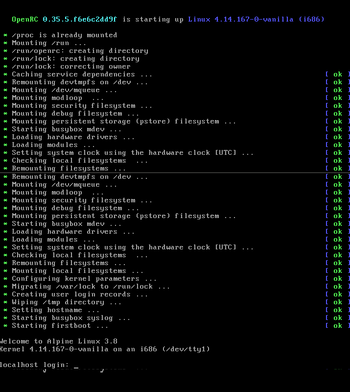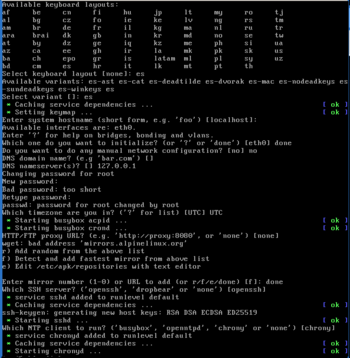Installation: Difference between revisions
Mckaygerhard (talk | contribs) |
Mckaygerhard (talk | contribs) No edit summary |
||
| Line 13: | Line 13: | ||
Highly '''recommended if you do not have great knowledge, to read [[Requirements|wiki page for requirements]]''': [[Requirements]]! | Highly '''recommended if you do not have great knowledge, to read [[Requirements|wiki page for requirements]]''': [[Requirements]]! | ||
[[File:Installation-alpine-alpine-setup-2-boot.png|350px|thumb|right|Installation : setup-alpine : booting process until login prompt]] | |||
= Installation Overview = | = Installation Overview = | ||
| Line 28: | Line 30: | ||
== 3. Boot and install process == | == 3. Boot and install process == | ||
'''Log-in as the user <code>root</code> with its initially empty password. Then execute <code>[[Alpine_setup_scripts#setup-alpine|setup-alpine]]</code>''' | '''Log-in as the user <code>root</code> with its initially empty password. Then execute <code>[[Alpine_setup_scripts#setup-alpine|setup-alpine]]</code>''' here you can perform that questions and hit ''enter'' on each answer: | ||
[[File:Installation-alpine-alpine-setup-3-setup-scripts.png|350px|thumb|right|Installation : setup-alpine : complete process single install]] | |||
* '''Select keyboard layout''': Let you to perform the keyborad layout, e.g. ''us'' or ''es'' | |||
** '''Select keyboard variant''': Choose your keyboard variant, e.g. ''us-nodeadkeys'' or ''es-winkeys'' respectively | |||
* '''Host name''', which will be the name of your computer; '''localhost''' are enough and recommended for starting. | |||
* '''Initialize network cards''': here most people can just go with the default (just press enter). | |||
** '''Any other configuration''': about any other configuration, just type "no" and hit enter | |||
** '''Select domain name''': if asked this are not commonly asked.. just hit enter. | |||
* '''DNS nameservers?''': if asked just type <code>8.8.8.8</code> and hit enter. | |||
* '''Changing password for root''': Next a root password must be defined, input a pass phrase, chars will not be show. | |||
** '''retype password''', input twice for confirmation, when typed no chars will be show. | |||
* '''Witch timezone to choose?''': just hit enter to use <code>UTC</code> when perform a single installation. | |||
* '''Proxy chooser''': just type <code>none</code> and hit enter if you have direct internet connection. | |||
* '''Enter mirror repository''': .. just type <code>1</code> and then press enter | |||
* '''Witch ssh server?''': Choose an SSH server allows you to remotely manage your machine. Just type enter. | |||
* '''Witch NTP client to run?''' This is for time sync, just press enter to use default. | |||
* '''Setup Disk''' This will setup the destination usage of the files | |||
** '''Witch disk choose to use?''': To choose the disk destination .. commonly sda are the hard disk cos sdb the USB boot or CD/DVD image | |||
** '''How would be used?''': type of installation (described at [[Alpine_setup_scripts#Setup_modes|Setup modes section at Alpine setup scripts]]), just type "sys" and then press enter, is the familiar install to disk well knowed for usage as main OS to computers. | |||
After the | After al the scripts setup ends, a "reboot" will be offered: | ||
* If the configured [[Alpine_setup_scripts#sys_mode|runtime mode was "sys"]], then remove the initial installation media to boot the newly installed system. | * If the configured [[Alpine_setup_scripts#sys_mode|runtime mode was "sys"]], then remove the initial installation media to boot the newly installed system. | ||
Revision as of 23:10, 19 July 2020
Installation It means use as main system in physical machine, bare metal or embebed device. Unless Alpine Linux are most used inside docker and containers.. this document will described how Alpine Linux could be also put over a hardware to use as main operating system.

By example as do in smartphones by the PostmarketOS system (an operatiing system for smartphones based on Alpine Linux) or as Desktop over a computer like Adelie Linux. In fact, Alpine Linux are already installed in your media dumped, it means downloadble media files of Alpine Linux are already the system ready to use (live system) directly from the media where are dumped!
Quick Requirements
This is a simple and quick reference list, nowadays any hardware is supported for Alpine Linux:
- At least 128 Megs of RAM for server without graphical GUI, or at least 1.6 Gigs for graphical desktop
- At least 1 Gigs storage device for server without graphical GUI, or at least 10 Gigs for graphical desktop with web browsing
Highly recommended if you do not have great knowledge, to read wiki page for requirements: Requirements!

Installation Overview
The most used are traditional way of booting and installing from media, but more specific or other architecture or machines (e.g. ARM, RPi, etc) are defined in Installation:_Use_cases wiki pages.
1. Download the media source
Just grab from stable-release ISO image. Take note of architectures in green buttons.
2. Dump, burn or flash the image
Dump the ISO image onto a media source like USB/SD flashing; or CD/DVD/BR disk with burning software. For more detailed on this topic check Additional Details section
3. Boot and install process
Log-in as the user root with its initially empty password. Then execute setup-alpine here you can perform that questions and hit enter on each answer:

- Select keyboard layout: Let you to perform the keyborad layout, e.g. us or es
- Select keyboard variant: Choose your keyboard variant, e.g. us-nodeadkeys or es-winkeys respectively
- Host name, which will be the name of your computer; localhost are enough and recommended for starting.
- Initialize network cards: here most people can just go with the default (just press enter).
- Any other configuration: about any other configuration, just type "no" and hit enter
- Select domain name: if asked this are not commonly asked.. just hit enter.
- DNS nameservers?: if asked just type
8.8.8.8and hit enter. - Changing password for root: Next a root password must be defined, input a pass phrase, chars will not be show.
- retype password, input twice for confirmation, when typed no chars will be show.
- Witch timezone to choose?: just hit enter to use
UTCwhen perform a single installation. - Proxy chooser: just type
noneand hit enter if you have direct internet connection. - Enter mirror repository: .. just type
1and then press enter - Witch ssh server?: Choose an SSH server allows you to remotely manage your machine. Just type enter.
- Witch NTP client to run? This is for time sync, just press enter to use default.
- Setup Disk This will setup the destination usage of the files
- Witch disk choose to use?: To choose the disk destination .. commonly sda are the hard disk cos sdb the USB boot or CD/DVD image
- How would be used?: type of installation (described at Setup modes section at Alpine setup scripts), just type "sys" and then press enter, is the familiar install to disk well knowed for usage as main OS to computers.
After al the scripts setup ends, a "reboot" will be offered:
- If the configured runtime mode was "sys", then remove the initial installation media to boot the newly installed system.
- If the configured runtime mode was "data", then keep installation media to boot the newly installed system.
The relevant commands for this are reboot or poweroff, after exits from setup-alpine process.
Additional Details
setup-alpine, can be used to configure the pre-install and installation, next section will explain each question.Further Documentation
After the system has been installed, it has only placed the operating system, but things like internet browser or movie viewer are not yet installed, things like web server or mail server neither much less. For that you must check Tutorials_and_Howtos Post-Install section